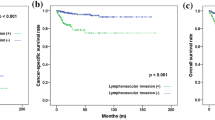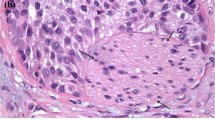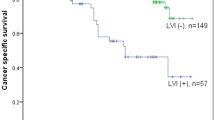Abstract
Background
To examine the prognostic value of lymphovascular invasion (LVI) in different tumor locations (i.e., renal pelvis and ureter) of upper urinary tract urothelial carcinoma (UTUC).
Methods
Data from a total of 250 patients with nonmetastatic UTUC who received radical nephroureterectomy between 2004 and 2010 at our institution were analyzed retrospectively. The significance of LVI and other relevant factors on cancer-specific survival (CSS), metastasis-free survival (MFS), and intraluminal recurrence-free survival (IRFS) were evaluated.
Results
Lymphovascular invasion was present in 60 patients (24 %) and was related to advanced pathological T stage (P < 0.001), higher tumor grade (P < 0.001), lymph node metastasis (P = 0.005), and pyelocaliceal tumor location (P = 0.002). By Kaplan–Meier analysis, LVI was found to be significantly correlated with worse CSS and MFS but not with IRFS. Multivariate analysis showed that high pathological T stage and regional lymph node involvement were significant prognostic factors for CSS and MFS, and LVI was an independent predictor for MFS (hazard ratio 1.71, 95 % confidence interval 1.00–2.93, P = 0.049). In patients with ureteral tumors, LVI represented the only significant prognosticator for both CSS and MFS in multivariate analysis. The prognostic value of LVI was not observed in pyelocaliceal tumors.
Conclusions
The implication of LVI on prognosis, particularly in ureteral tumors but not in pyelocaliceal tumors, may imply diverse disease characteristics between different tumor locations among UTUC. LVI is essential to identify patients at high risk for metastasis/mortality and can facilitate treatment planning and surveillance strategies, especially in patients with ureteral tumors.


Similar content being viewed by others
References
Roupret M, Babjuk M, Comperat E, et al. European guidelines on upper tract urothelial carcinomas: 2013 update. Eur Urol. 2013;63:1059–71.
Li CC, Chang TH, Wu WJ, et al. Significant predictive factors for prognosis of primary upper urinary tract cancer after radical nephroureterectomy in Taiwanese patients. Eur Urol. 2008;54:1127–34.
Li WM, Shen JT, Li CC, et al. Oncologic outcomes following three different approaches to the distal ureter and bladder cuff in nephroureterectomy for primary upper urinary tract urothelial carcinoma. Eur Urol. 2010;57:963–9.
Verhoest G, Shariat SF, Chromecki TF, et al. Predictive factors of recurrence and survival of upper tract urothelial carcinomas. World J Urol. 2011;29:495–501.
Saito K, Kawakami S, Fujii Y, Sakura M, Masuda H, Kihara K. Lymphovascular invasion is independently associated with poor prognosis in patients with localized upper urinary tract urothelial carcinoma treated surgically. J Urol. 2007;178:2291–6.
Eisenberg MS, Boorjian SA, Cheville JC, et al. The SPARC score: a multifactorial outcome prediction model for patients undergoing radical cystectomy for bladder cancer. J Urol. 2013;190:2005–10.
Lee JH, Jang HS, Kim JG, et al. Lymphovascular invasion is a significant prognosticator in rectal cancer patients who receive preoperative chemoradiotherapy followed by total mesorectal excision. Ann Surg Oncol. 2012;19:1213–21.
Baydar DE, Baseskioglu B, Ozen H, Geyik PO. Prognostic significance of lymphovascular invasion in clinically localized prostate cancer after radical prostatectomy. Sci World J. 2008;17:303–12.
Godfrey MS, Badalato GM, Hruby GW, Razmjoo M, McKiernan JM. Prognostic indicators for upper tract urothelial carcinoma after radical nephroureterectomy: the impact of lymphovascular invasion. BJU Int. 2012;110:798–803.
Matsumoto K, Novara G, Gupta A, et al. Racial differences in the outcome of patients with urothelial carcinoma of the upper urinary tract: an international study. BJU Int. 2011;108(8 Pt 2):E304–9.
Lin WC, Hu FC, Chung SD, Chueh SC, Pu YS, Huang KH. The role of lymphovascular invasion in predicting the prognosis of clinically localized upper tract urothelial carcinoma (pT1-3cN0M0). J Urol. 2008;180:879–84.
Chung SD, Wang SM, Lai MK, et al. Lymphovascular invasion predicts poor outcome of urothelial carcinoma of renal pelvis after nephroureterectomy. BJU Int. 2009;103:1047–51.
Ku JH, Byun SS, Jeong H, Kwak C, Kim HH, Lee SE. Lymphovascular invasion as a prognostic factor in the upper urinary tract urothelial carcinoma: a systematic review and meta-analysis. Eur J Cancer. 2013;49:2665–80.
Cheng L, Jones TD, Lin H, et al. Lymphovascular invasion is an independent prognostic factor in prostatic adenocarcinoma. J Urol. 2005;174:2181–5.
Lotan Y, Gupta A, Shariat SF, et al. Lymphovascular invasion is independently associated with overall survival, cause-specific survival, and local and distant recurrence in patients with negative lymph nodes at radical cystectomy. J Clin Oncol. 2005;23:6533–9.
Hong B, Park S, Hong JH, Kim CS, Ro JY, Ahn H. Prognostic value of lymphovascular invasion in transitional cell carcinoma of upper urinary tract. Urology. 2005;65:692–6.
Hurel S, Rouprêt M, Ouzzane A, et al. Impact of lymphovascular invasion on oncological outcomes in patients with upper tract urothelial carcinoma after radical nephroureterectomy. BJU Int. 2013;111:1199–207.
Margulis V, Shariat SF, Matin SF, et al. Outcomes of radical nephroureterectomy: a series from the Upper Tract Urothelial Carcinoma Collaboration. Cancer. 2009;115:1224–33.
Akao J, Matsuyama H, Yamamoto Y, et al. Clinical significance of lymphovascular invasion in upper urinary tract urothelial cancer. BJU Int. 2008;102:572–5.
Ouzzane A, Colin P, Ghoneim TP, et al. The impact of lymph node status and features on oncological outcomes in urothelial carcinoma of the upper urinary tract (UTUC) treated by nephroureterectomy. World J Urol. 2013;31:189–97.
Cha EK, Shariat SF, Kormaksson M, et al. Predicting clinical outcomes after radical nephroureterectomy for upper tract urothelial carcinoma. Eur Urol. 2012;61:818–25.
Novara G, Matsumoto K, Kassouf W, et al. Prognostic role of lymphovascular invasion in patients with urothelical carcinoma of the upper urinary tract: an international validation study. Eur Urol. 2010;57:1064–71.
Zou L, Zhang L, Zhang H, Jiang H, Ding Q. Comparison of post-operative intravesical recurrence and oncological outcomes after open versus laparoscopic nephroureterectomy for upper urinary tract urothelial carcinoma. World J Urol. 2014;32:565–70.
Chromecki TF, Cha EK, Fajkovic H, et al. The impact of tumor multifocality on outcomes in patients treated with radical nephroureterectomy. Eur Urol. 2012;61:245–53.
Pignot G, Colin P, Zerbib M, et al. Influence of previous or synchronous bladder cancer on oncologic outcomes after radical nephroureterectomy for upper urinary tract urothelial carcinoma. Urol Oncol. 2014;32:23.e1–8.
Yafi FA, Novara G, Shariat SF, et al. Impact of tumour location versus multifocality in patients with upper tract urothelial carcinoma treated with nephroureterectomy and bladder cuff excision: a homogeneous series without perioperative chemotherapy. BJU Int. 2012;110(2 Pt 2):E7–13.
Kikuchi E, Margulis V, Karakiewicz PI, et al. Lymphovascular invasion predicts clinical outcomes in patients with node-negative upper tract urothelial carcinoma. J Clin Oncol. 2009;27:612–8.
Ouzzane A, Colin P, Xylinas E, et al. Ureteral and multifocal tumours have worse prognosis than renal pelvic tumours in urothelial carcinoma of the upper urinary tract treated by nephroureterectomy. Eur Urol. 2011;60:1258–65.
Williams AK, Kassouf W, Chin J, et al. Multifocality rather than tumor location is a prognostic factor in upper tract urothelial carcinoma. Urol Oncol. 2013;31:1161–5.
Li WM, Li CC, Ke HL, Wu WJ, Huang CN, Huang CH. The prognostic predictors of primary ureteral transitional cell carcinoma after radical nephroureterectomy. J Urol. 2009;182:451–8.
Raman JD, Messer J, Sielatycki JA, Hollenbeak CS. Incidence and survival of patients with carcinoma of the ureter and renal pelvis in the USA, 1973–2005. BJU Int. 2011;107:1059–64.
Chen XP, Xiong GY, Li XS, et al. Predictive factors for worse pathological outcomes of upper tract urothelial carcinoma: experience from a nationwide high-volume centre in China. BJU Int. 2013;112:917–24.
Matin SF, Shariat SF, Milowsky MI, et al. Highlights from the first symposium on upper tract urothelial carcinoma. Urol Oncol. 2014;32:309–16.
Acknowledgment
This study was supported by grants from the Kaohsiung Medical University Hospital (KMUH 97-7G06), the Center for Infectious Disease and Cancer Research, Kaohsiung Medical University (KMU-TP103E19), and the Health and Welfare Surcharge of tobacco products, Ministry of Health and Welfare (MOHW103-TD-B-111-05).
Disclosure
The authors declare no conflict of interest.
Author information
Authors and Affiliations
Corresponding authors
Additional information
Hsiang-Ying Lee and Ching-Chia Li contributed equally to this article, and both should be considered first author.
Rights and permissions
About this article
Cite this article
Lee, HY., Li, CC., Huang, CN. et al. Prognostic Significance of Lymphovascular Invasion in Upper Urinary Tract Urothelial Carcinoma is Influenced by Tumor Location. Ann Surg Oncol 22, 1392–1400 (2015). https://doi.org/10.1245/s10434-014-4103-x
Received:
Published:
Issue Date:
DOI: https://doi.org/10.1245/s10434-014-4103-x




